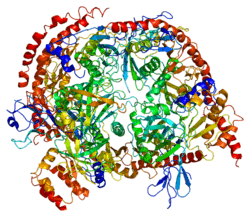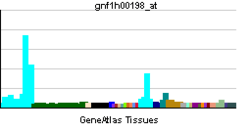Exosome component 3
| View/Edit Human | View/Edit Mouse |
Exosome component 3, also known as EXOSC3, is a human gene, which is part of the exosome complex.[3]
Clinical significance
Mutations in EXOSC3 cause pontocerebellar hypoplasia and spinal motor neuron degeneration.[4]
References
- ↑ "Human PubMed Reference:".
- ↑ "Mouse PubMed Reference:".
- ↑ "Entrez Gene: EXOSC3 exosome component 3".
- ↑ Wan J, Yourshaw M, Mamsa H, Rudnik-Schöneborn S, Menezes MP, Hong JE, Leong DW, Senderek J, Salman MS, Chitayat D, Seeman P, von Moers A, Graul-Neumann L, Kornberg AJ, Castro-Gago M, Sobrido MJ, Sanefuji M, Shieh PB, Salamon N, Kim RC, Vinters HV, Chen Z, Zerres K, Ryan MM, Nelson SF, Jen JC (2012). "Mutations in the RNA exosome component gene EXOSC3 cause pontocerebellar hypoplasia and spinal motor neuron degeneration". Nat. Genet. 44 (6): 704–8. doi:10.1038/ng.2254. PMC 3366034
 . PMID 22544365.
. PMID 22544365.
Further reading
- Allmang C, Petfalski E, Podtelejnikov A, et al. (1999). "The yeast exosome and human PM-Scl are related complexes of 3' --> 5' exonucleases.". Genes Dev. 13 (16): 2148–58. doi:10.1101/gad.13.16.2148. PMC 316947
 . PMID 10465791.
. PMID 10465791. - Lai CH, Chou CY, Ch'ang LY, et al. (2000). "Identification of novel human genes evolutionarily conserved in Caenorhabditis elegans by comparative proteomics.". Genome Res. 10 (5): 703–13. doi:10.1101/gr.10.5.703. PMC 310876
 . PMID 10810093.
. PMID 10810093. - Brouwer R, Allmang C, Raijmakers R, et al. (2001). "Three novel components of the human exosome.". J. Biol. Chem. 276 (9): 6177–84. doi:10.1074/jbc.M007603200. PMID 11110791.
- Chen CY, Gherzi R, Ong SE, et al. (2002). "AU binding proteins recruit the exosome to degrade ARE-containing mRNAs.". Cell. 107 (4): 451–64. doi:10.1016/S0092-8674(01)00578-5. PMID 11719186.
- Andersen JS, Lyon CE, Fox AH, et al. (2002). "Directed proteomic analysis of the human nucleolus.". Curr. Biol. 12 (1): 1–11. doi:10.1016/S0960-9822(01)00650-9. PMID 11790298.
- Raijmakers R, Noordman YE, van Venrooij WJ, Pruijn GJ (2002). "Protein-protein interactions of hCsl4p with other human exosome subunits.". J. Mol. Biol. 315 (4): 809–18. doi:10.1006/jmbi.2001.5265. PMID 11812149.
- Brouwer R, Vree Egberts WT, Hengstman GJ, et al. (2002). "Autoantibodies directed to novel components of the PM/Scl complex, the human exosome.". Arthritis Res. 4 (2): 134–8. doi:10.1186/ar389. PMC 83843
 . PMID 11879549.
. PMID 11879549. - Raijmakers R, Egberts WV, van Venrooij WJ, Pruijn GJ (2002). "Protein-protein interactions between human exosome components support the assembly of RNase PH-type subunits into a six-membered PNPase-like ring.". J. Mol. Biol. 323 (4): 653–63. doi:10.1016/S0022-2836(02)00947-6. PMID 12419256.
- Strausberg RL, Feingold EA, Grouse LH, et al. (2003). "Generation and initial analysis of more than 15,000 full-length human and mouse cDNA sequences.". Proc. Natl. Acad. Sci. U.S.A. 99 (26): 16899–903. doi:10.1073/pnas.242603899. PMC 139241
 . PMID 12477932.
. PMID 12477932. - Gherzi R, Lee KY, Briata P, et al. (2004). "A KH domain RNA binding protein, KSRP, promotes ARE-directed mRNA turnover by recruiting the degradation machinery.". Mol. Cell. 14 (5): 571–83. doi:10.1016/j.molcel.2004.05.002. PMID 15175153.
- Lehner B, Sanderson CM (2004). "A protein interaction framework for human mRNA degradation.". Genome Res. 14 (7): 1315–23. doi:10.1101/gr.2122004. PMC 442147
 . PMID 15231747.
. PMID 15231747. - Gerhard DS, Wagner L, Feingold EA, et al. (2004). "The status, quality, and expansion of the NIH full-length cDNA project: the Mammalian Gene Collection (MGC).". Genome Res. 14 (10B): 2121–7. doi:10.1101/gr.2596504. PMC 528928
 . PMID 15489334.
. PMID 15489334. - Rual JF, Venkatesan K, Hao T, et al. (2005). "Towards a proteome-scale map of the human protein-protein interaction network.". Nature. 437 (7062): 1173–8. doi:10.1038/nature04209. PMID 16189514.
This article is issued from Wikipedia - version of the 5/27/2016. The text is available under the Creative Commons Attribution/Share Alike but additional terms may apply for the media files.


